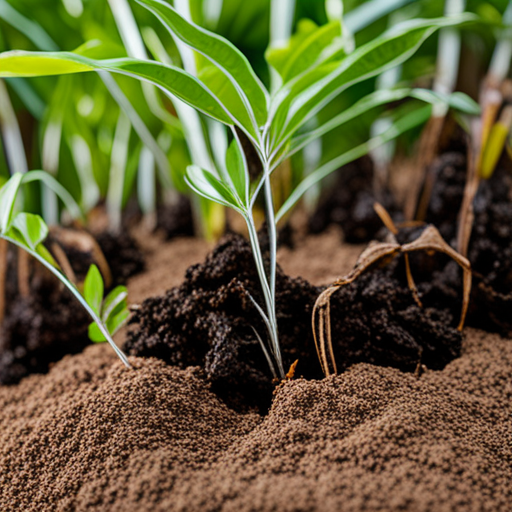While bamboo can adapt to various soil types, certain species, like Moso bamboo, have specific requirements for optimal growth. In-ground bamboo flourishes in slightly moist, light, and well-drained soil, preferably loamy soil that combines sand, silt, and clay. This type of soil retains moisture without waterlogging, allows for proper oxygenation of bamboo roots and rhizomes, prevents drought stress, and effectively holds nutrients.
For container bamboo, ensuring proper drainage is essential, achieved by using a layer of coarse river sand at the bottom. Fertilizing with slow-release fertilizer twice a year replenishes nutrients and promotes growth. Additionally, adding organic material, such as compost and sand, can enhance soil quality.
This article will delve into the various aspects of optimal soil conditions for thriving bamboo growth, providing valuable insights for successful cultivation.
Contents
Our Highlighted Points
- Bamboo can grow in various types of soil, including clay-heavy, sandy, loamy, and rocky.
- Good soil conditions are important for optimal bamboo growth, both in-ground and in containers.
- The recommended soil mixture for container bamboo is 75% Miracle-Gro® Moisture Control® Potting Mix, 20% composted manure, and 5% biochar.
What Bamboo Needs

Optimal soil conditions are crucial for promoting healthy growth and development of bamboo. It requires well-draining, loamy soil with a slightly acidic pH and adequate nutrient availability. Composting plays a vital role in enhancing bamboo growth. It retains moisture and acidity in the soil, improves soil structure, increases nutrient content, and promotes beneficial microbial activity.
By incorporating compost into the soil mixture, bamboo can access essential nutrients gradually. This results in sustained growth and improved overall health. Additionally, proper watering is essential for bamboo health. It is important to ensure that the soil is consistently moist but not waterlogged. Excessive moisture can lead to root rot and other fungal diseases.
Balancing soil moisture levels and providing adequate drainage is key to maintaining optimal soil conditions for thriving bamboo growth.
Soil Composition

One important factor to consider when cultivating bamboo is the composition of the soil. Choosing the right soil for bamboo is crucial for its successful growth.
Here are some key points to keep in mind when it comes to soil amendments for thriving bamboo growth:
- Bamboo can grow in various types of soil, including clay-heavy, sandy, loamy, and rocky.
- Good soil conditions lead to better and healthier bamboo growth.
- For container bamboo, a recommended soil mixture is 75% Miracle-Gro® Moisture Control® Potting Mix, 20% composted manure, and 5% biochar.
- In-ground bamboo thrives in slightly moist, light, loosely textured soil with good drainage.
- Loamy soil, which combines sand, silt, and clay, is preferred by bamboo as it retains moisture without waterlogging and holds nutrients well.
By understanding and implementing these soil composition guidelines, bamboo enthusiasts can create optimal conditions for their plants to thrive.
Improving Soil Quality

Improving the quality of the soil is crucial for creating an environment conducive to the successful cultivation of bamboo.
There are several methods that can be employed to enhance the soil quality for optimal bamboo growth.
One effective method is the addition of organic material, such as compost and sand, to improve the texture and nutrient content of the soil. Compost helps retain moisture and acidity, while sand improves drainage in clay-heavy soils.
Another method is adjusting the soil pH using sulfur or lime, depending on the soil’s acidity or alkalinity, to create a moderately acidic environment that bamboo prefers.
These methods have numerous benefits, including better oxygenation of bamboo roots and rhizomes, prevention of drought stress, and improved nutrient availability.
By improving the soil quality, bamboo plants can thrive and reach their full potential.
What Are the Ideal Soil Conditions for Different Types of Bamboo?
Different types of bamboo thrive in varying soil conditions. For instance, clumping bamboo prefers well-draining soil with moderate moisture levels. Running bamboo, on the other hand, requires fertile soil rich in organic matter. The diverse uses of bamboo, from construction to crafts, make it important to understand and meet the specific soil requirements for optimal growth.
Frequently Asked Questions
How often should I water bamboo planted in loamy soil?
Bamboo planted in loamy soil should be watered regularly, ensuring the soil remains slightly moist. Overwatering can lead to root rot and other issues. Signs of overwatering include yellowing leaves, wilting, and a musty smell.
Can bamboo grow in soil with a high clay content?
Bamboo can grow in soil with a high clay content, but there are challenges to consider. Clay soil can hinder proper drainage and oxygenation, which may affect bamboo root development. Improving clay soil with organic material and sand can help create a more suitable environment for bamboo growth.
What is the best pH level for bamboo to thrive?
The best pH level for bamboo to thrive is moderately acidic, ranging from 6.5 to just under neutral 7. This pH range promotes healthy growth and nutrient absorption, ensuring the benefits of bamboo in landscaping are maximized.
Is it necessary to fertilize bamboo planted in containers?
Container gardening tips include fertilizing bamboo planted in containers. Using organic fertilizers can provide essential nutrients to promote growth and replace depleted nutrients. It helps maintain the health and vitality of bamboo in container gardening.
How often should I repot bamboo in containers?
Repotting frequency for bamboo in containers depends on the size of the container. It is generally recommended to repot every 3 years or sooner if the container becomes too small to prevent root-bound bamboo and ensure healthy growth.

